The final match of the 2021/2022 season saw Chelsea Women and Manchester City Women lock horns once more in the FA Cup final, with the latest instalment of this footballing rivalry coming after successful conclusions to the league campaign for both sides. Chelsea were on a high after securing their third consecutive WSL title, whilst Manchester City had ensured Champions League football next season after winning their final league game last weekend. The two teams had already met three times during the campaign, with Chelsea winning both league encounters and Manchester City getting the better of them in the Continental Cup final, so it was difficult to predict who would have the upper hand at Wembley Stadium.
This tactical analysis will look at both teams’ performances in this match, focusing on how Manchester City’s attacking setup helped them to take control of proceedings early on, as well as how Chelsea’s tactical changes helped them recover from a slow start to win the game.
Lineups

Chelsea Women manager Emma Hayes made just two changes to the side that defeated Manchester United Women last weekend to seal the title, with wing-backs Niamh Charles and Jonna Andersson dropping to the bench and being replaced by defender Aniek Nouwen and striker Beth England. Nouwen went into the back three as Jess Carter switched to right wing-back, whilst Norway international Guro Reiten also moved to wing-back and allowed England to partner Sam Kerr in the forward line. The other notable name in the matchday squad was Fran Kirby, who was included for the first time since February after being out with fatigue, and this gave both Hayes and England manager Sarina Wiegman a major boost.
Manchester City Women head coach Gareth Taylor also opted for minimal alterations, with Demi Stokes the only new name in the XI; the England left-back had missed the 4-0 win at Reading Women last Sunday due to her partner giving birth to their first child. Her replacement in that game, Norwegian January signing Julie Blakstad, dropped to the bench, whilst Ellen White was also among the replacements as Taylor opted to continue with Jamaica international Khadija Shaw as his target player. Georgia Stanway played her final game for the club, having this week joined Bayern Munich Frauen, whilst Alex Greenwood was given the captain’s armband in Steph Houghton’s continued injury absence.
Manchester City Women’s attacking play
Whilst Chelsea Women did eventually win this match, it was Manchester City Women who had the better start, getting on the front foot early and putting Chelsea’s players under pressure in their own third.

This was largely down to the role played by Georgia Stanway and Scotland midfielder Caroline Weir, who were the outside midfielders in their central three. As such, they were given licence to get forward and support attacks by getting in between Chelsea’s defenders and midfielders, with Chelsea finding it hard to defend against them. Here, they are unsure of whether to close the ball down or protect their goal, and the result is that some players are going forwards and some are staying back, with gaps appearing and the defending appearing to be disorganised. However, the fact that this is down to the driving runs by Weir and Stanway shows how Manchester City had a clear game plan and each player knew their role.
The other thing that came from their presence in the middle was that Chelsea’s attention was not on the wings, where Lauren Hemp and Chloe Kelly were. As a result, both wide forwards had the freedom to make runs behind the defenders and cause them problems, with Hemp in particular thriving throughout the match when in open space.
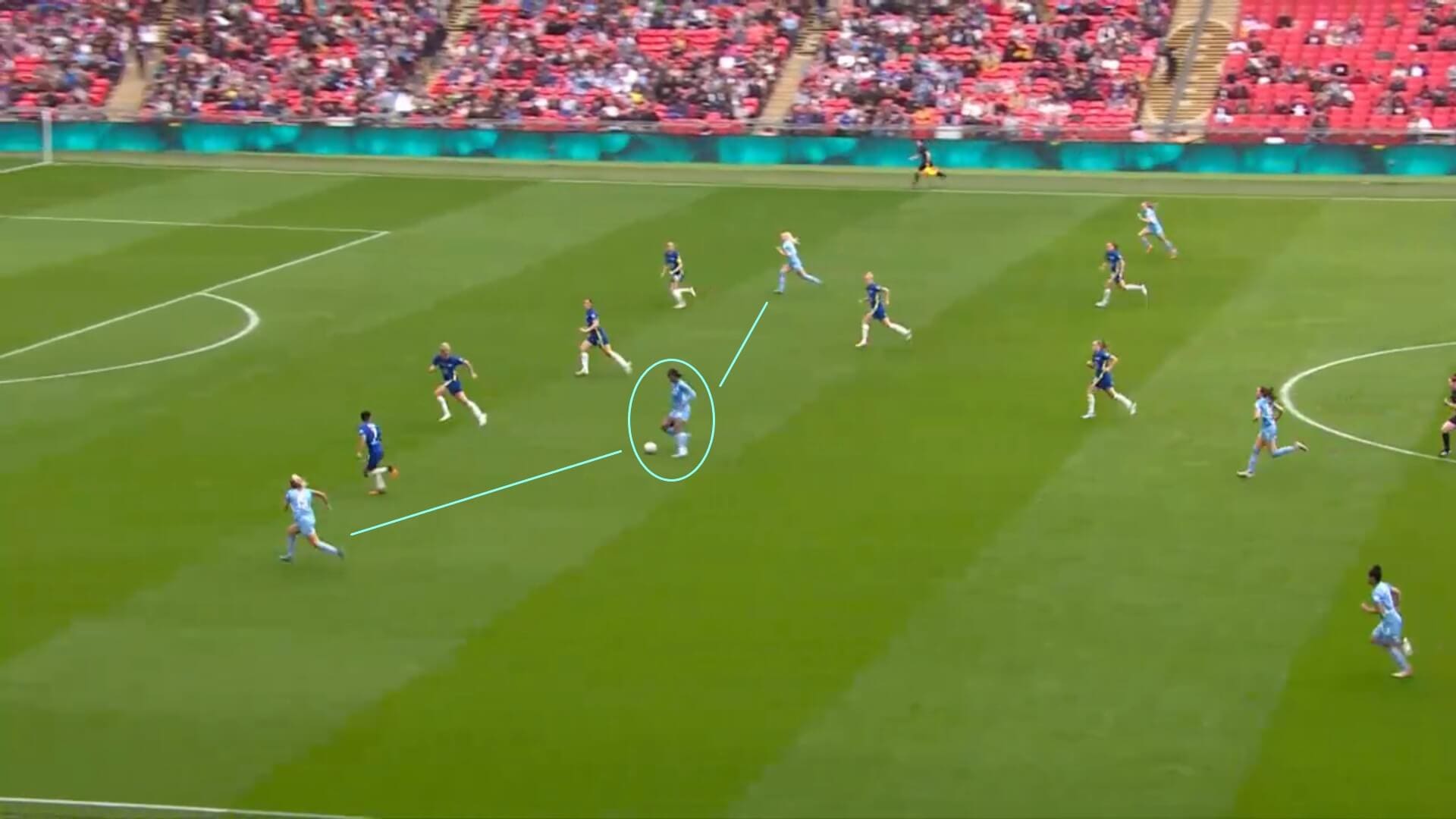
A key aspect of Manchester City’s attacking play was to keep their two wide threats as far up the pitch as possible and enabling that meant that Khadija Shaw had to drop back and receive shorter passes from her teammates. This led to the setup seen here, with Shaw in front of the Chelsea defenders and Kelly and Hemp further forward and either side of them.
Normally, Chelsea might have looked to close Shaw down here, but the fact that Kelly and Hemp were ready to exploit the space behind them if given a chance to do so meant that this wasn’t possible. As a result, Shaw had time to turn and find either Kelly or Hemp ahead of her when she did get the ball, and this was another reason that Manchester City looked the better side for large parts of the first half.
However, whilst this setup was key in helping them to create chances, Manchester City’s problem was that they couldn’t finish them off, with their final passes or efforts on goal generally lacking quality. Different players were guilty of having a poor shot on goal or making a wrong decision at times, and this was one key reason for Manchester City not running away with the game, despite their organised attacking play.
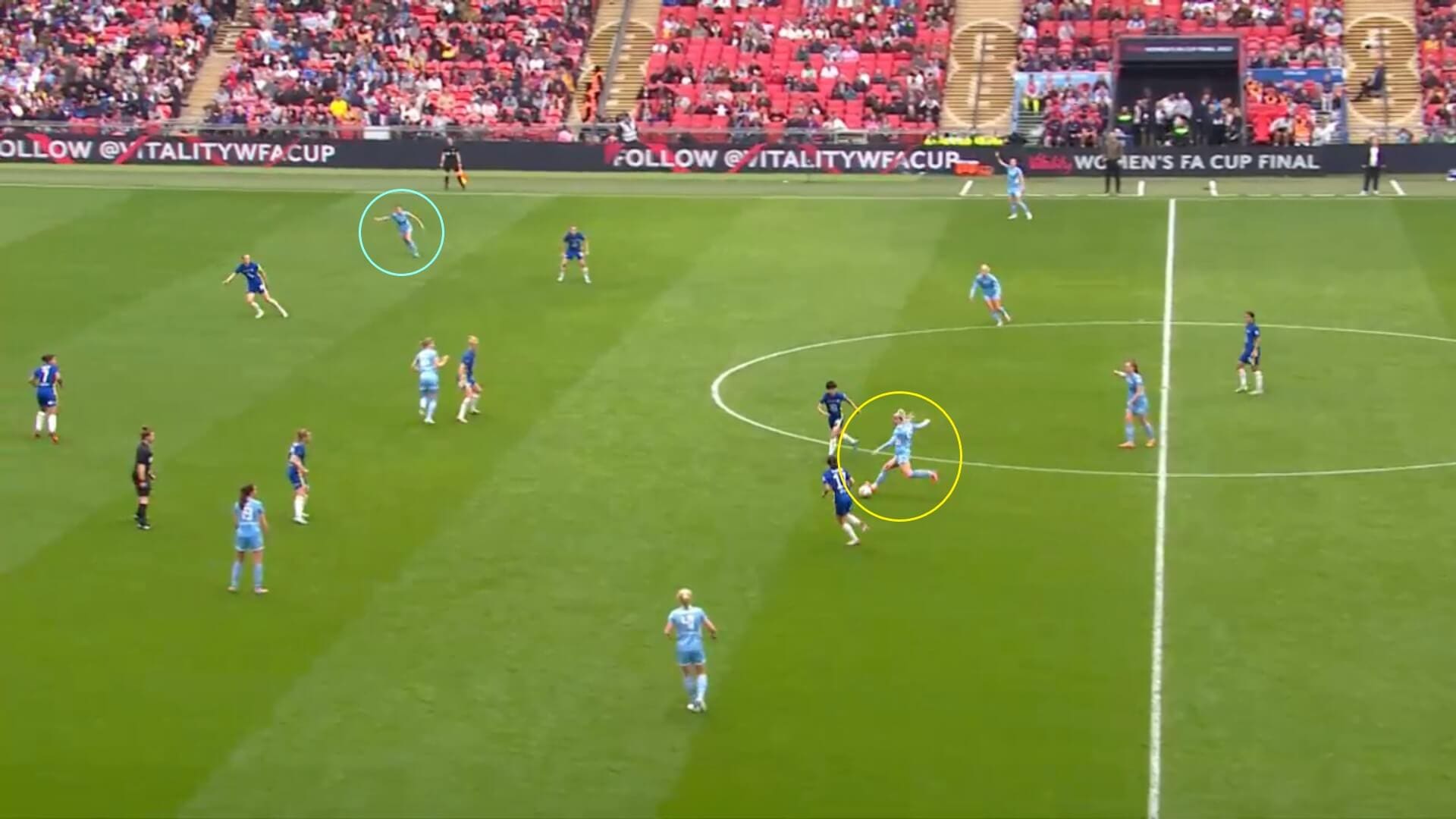
As a result of their failure to convert their chances, Chelsea ended up taking the lead twice, with Hemp’s curling effort Manchester City’s sole reward for their attacking efforts. Taylor therefore introduced former Everton Women winger Hayley Raso for Chloe Kelly in the second half, with the Australia international offering a direct goal threat in contrast to the England forward’s tendency to cross into the box from wider areas. The intent was clear; Manchester City needed another goalscoring threat on the pitch and wanted to reapply the pressure on the defenders that had been so prominent beforehand.
Once Raso was on the pitch, Manchester City’s focus turned towards playing longer balls towards both wings from the middle, progressing the ball up the field and trying to expose the gaps either side of Chelsea’s central defenders, and both Alex Greenwood and Keira Walsh continually looked wide whenever they had possession. Once the ball reached either Raso or Hemp, Chelsea struggled to contain them, with Raso’s equaliser just before full-time coming from a long ball like this one that was misjudged by Chelsea captain Magdalena Eriksson, allowing the former to hold her off and score.
Therefore, whilst Manchester City did finish as runners-up in this cup final, they deserve a lot of credit for their desire to get back into the game, with their amazing attacking play (in Gareth Taylor’s post-match words) keeping them in with a chance of winning right up until the final whistle, and this is what their head coach will be most pleased about.
Chelsea Women’s early play
In contrast to Manchester City Women’s fast start, Chelsea Women took a while to find their feet in this match, with this analysis already highlighting how they gave their opponents too much space at times and allowed them to get into dangerous areas of the pitch.
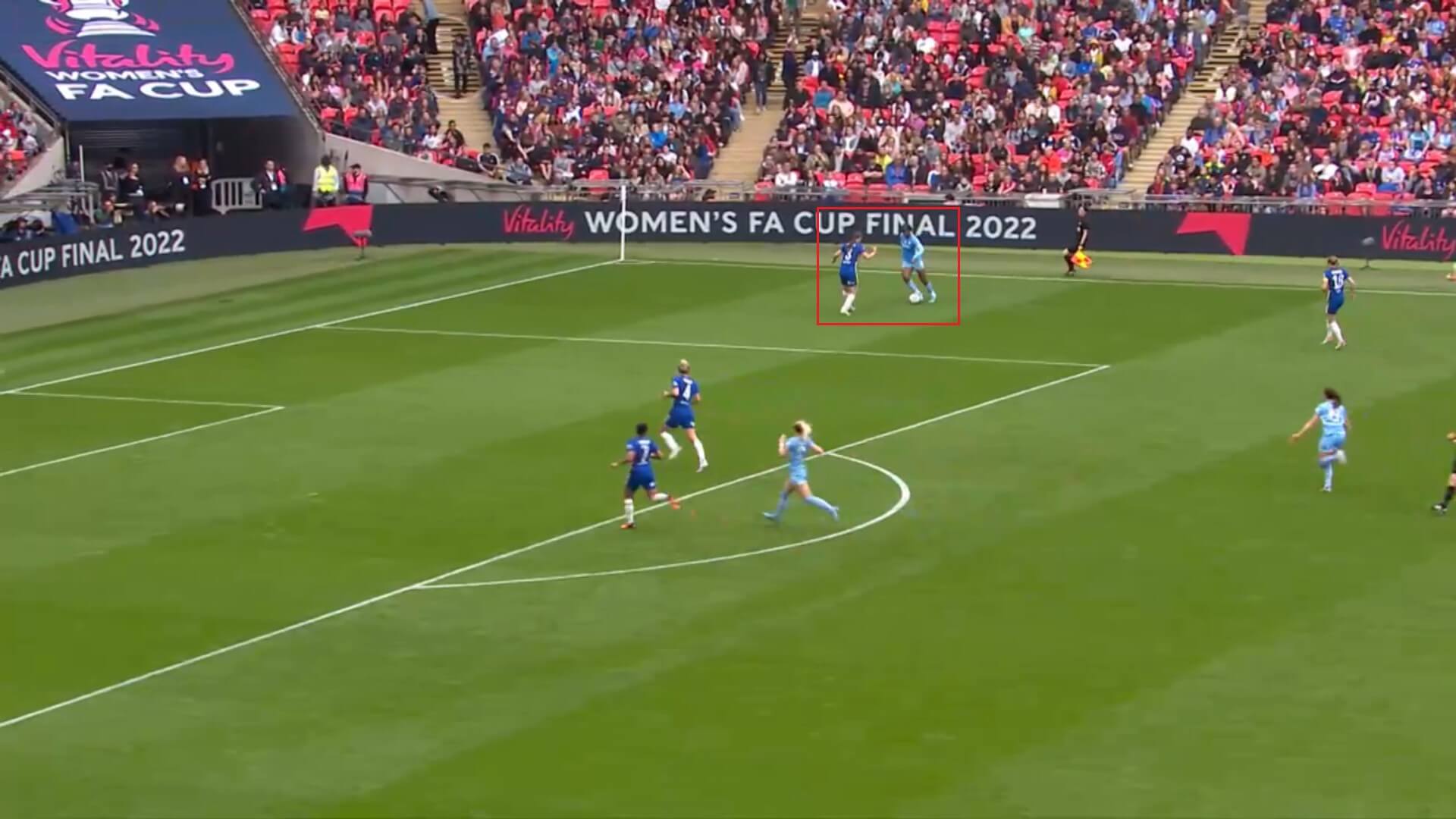
Defensively, they did look suspect on a number of occasions, with 1-v-1 duels something that they really struggled with. Here, Aniek Nouwen has gone out to close the ball down, but Shaw ends up moving the ball around the Netherlands international a little too easily, giving her an open route into the goal area, whilst Hemp’s equaliser came from Millie Bright not getting tight enough to her England teammate, and we have already mentioned how Raso’s goal was the result of Eriksson losing out in another individual battle.
What is notable about this is that the three players mentioned are all centre-backs, and this was because they lacked support from the two wing-backs when defending, meaning that they were having to get out to balls but also try to prevent Manchester City from playing through them. When Chelsea first introduced their 3-4-3 system at the beginning of this campaign, early analysis indicated some defensive issues with the wing-backs not tracking back to help out, and the opening day loss to Arsenal Women exposed this weakness. Whilst this has improved as the season has gone on, this game saw them slip back towards those defensive lapses, with the result being situations like this.
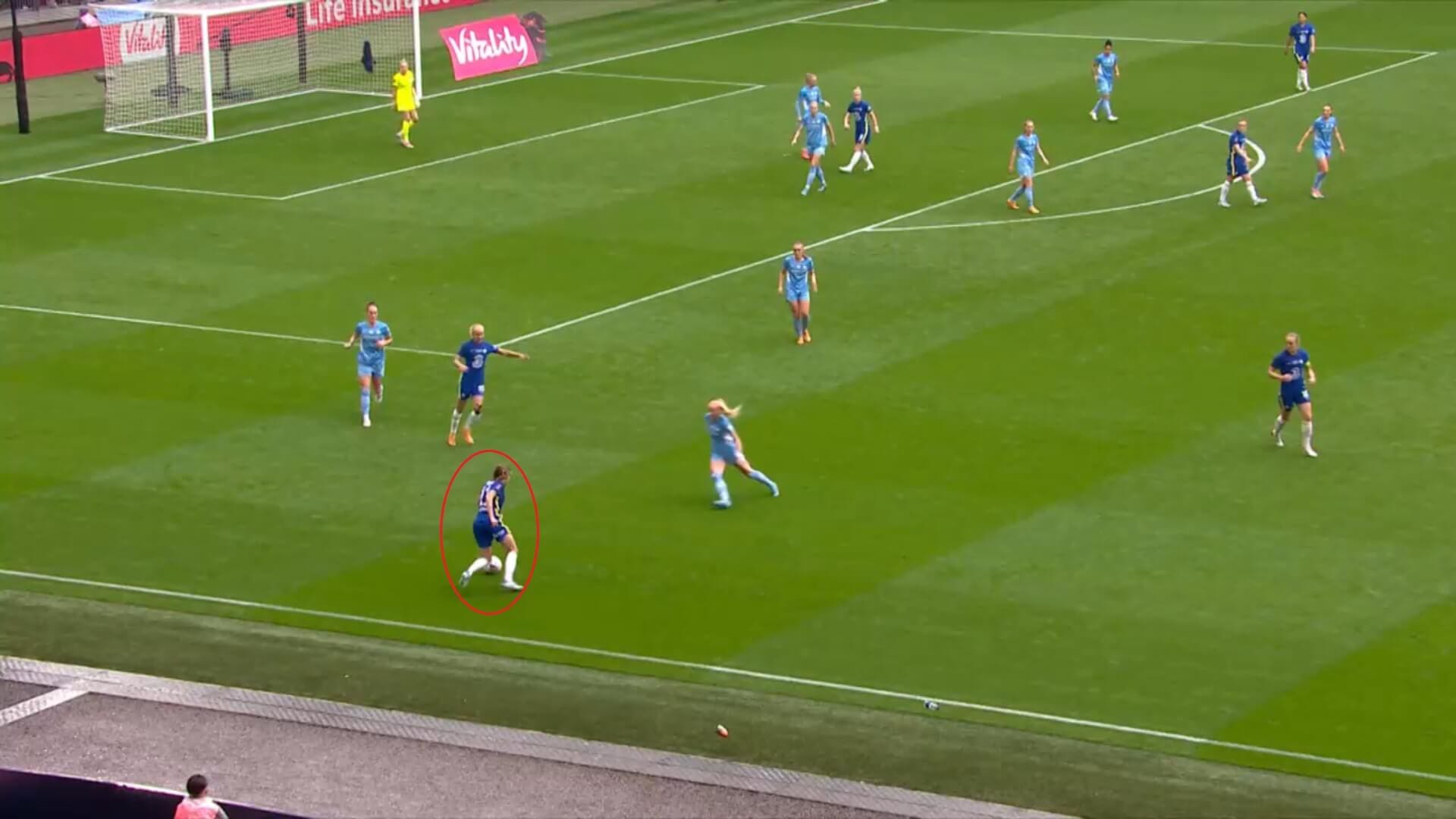
However, the attacking side of the wing-back system has really benefitted Emma Hayes’ side this season, allowing them to get more players into the final third and pose a bigger threat in the middle. In this game, it was important that they had these numbers available, with spaces at a premium around Manchester City’s goal area. Therefore, the wing-backs played a crucial role in the team keeping possession and waiting for the right moment to put the ball into any open spaces that they found, as well as creating triangles that helped to move the ball around individual opponents and build their attacks. Here, Chelsea might have looked to pass backwards when faced with this number of opponents, but Reiten’s presence has allowed them to keep the ball high up the pitch, and this is why they have been so difficult to keep out.
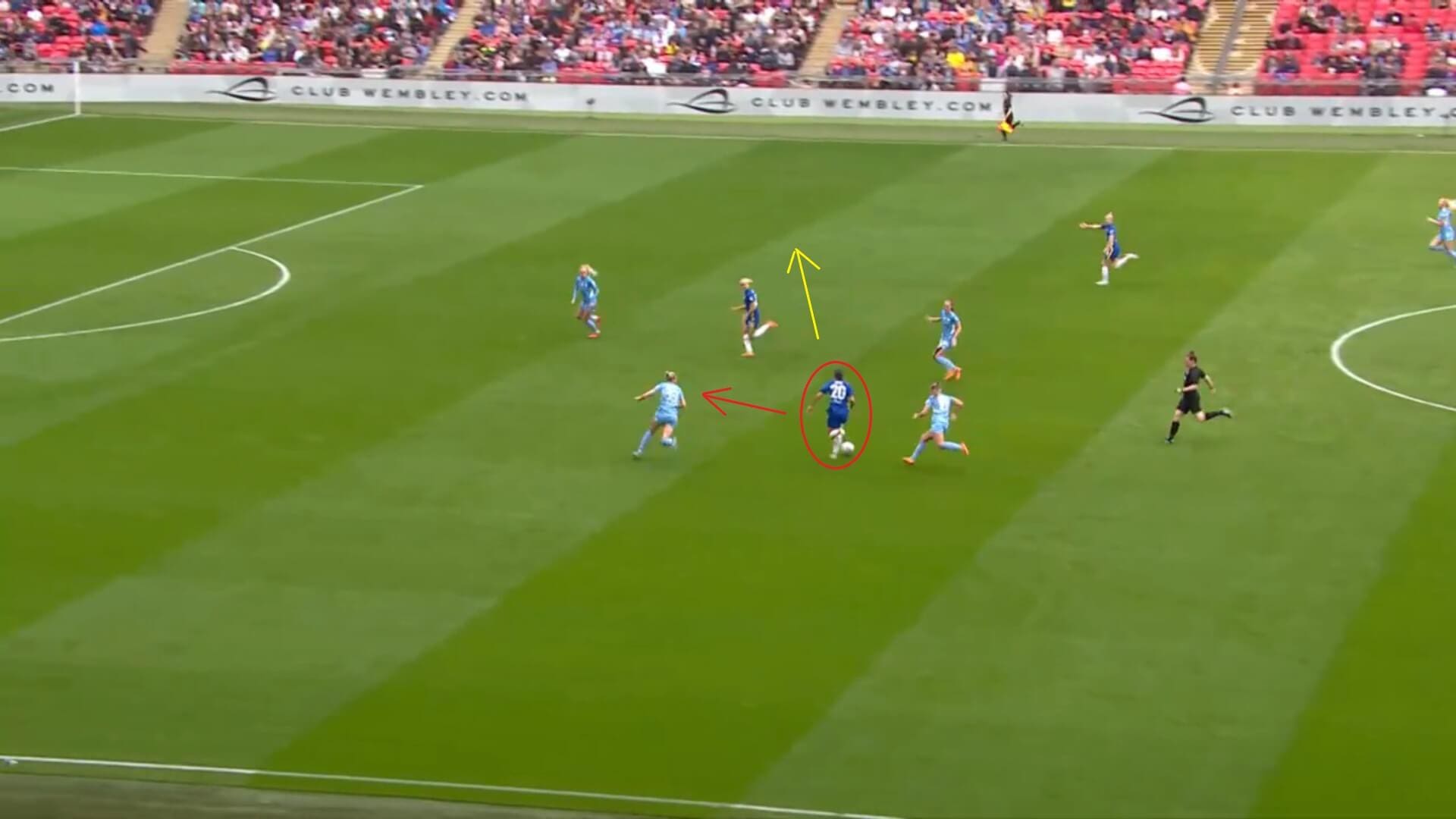
The advantage for those in the middle of having wing-backs is that they can work more closely together, but, despite Reiten and Jess Carter getting up the field to enable this link-up play to happen, the trio of England, Kerr and Harder were missing their usual fluency. Here, Kerr is looking to move the ball into one of the other two attackers and opts to pass towards Harder, as shown by the red arrow, rather than Beth England, who is in more space and would be able to meet the ball at speed. As a result, the ball enters a congested area and Manchester City are able to regain possession and clear the danger.
Whether this was down to poor decision making or simply that Kerr didn’t see England’s run, the point is still the same; Chelsea’s attackers weren’t clicking with each other as well as they normally do, and when we combine this with their defensive problems, we can see why they struggled at times during the first half.
Chelsea Women’s tactical changes
We have already looked at how Manchester City Women made alterations to their personnel in the second half in order to keep the pressure on Chelsea Women, but Emma Hayes opted instead to introduce new tactics in her desire to take control of the match, with her side looking much more potent in attack and harder to beat at the back as a result.
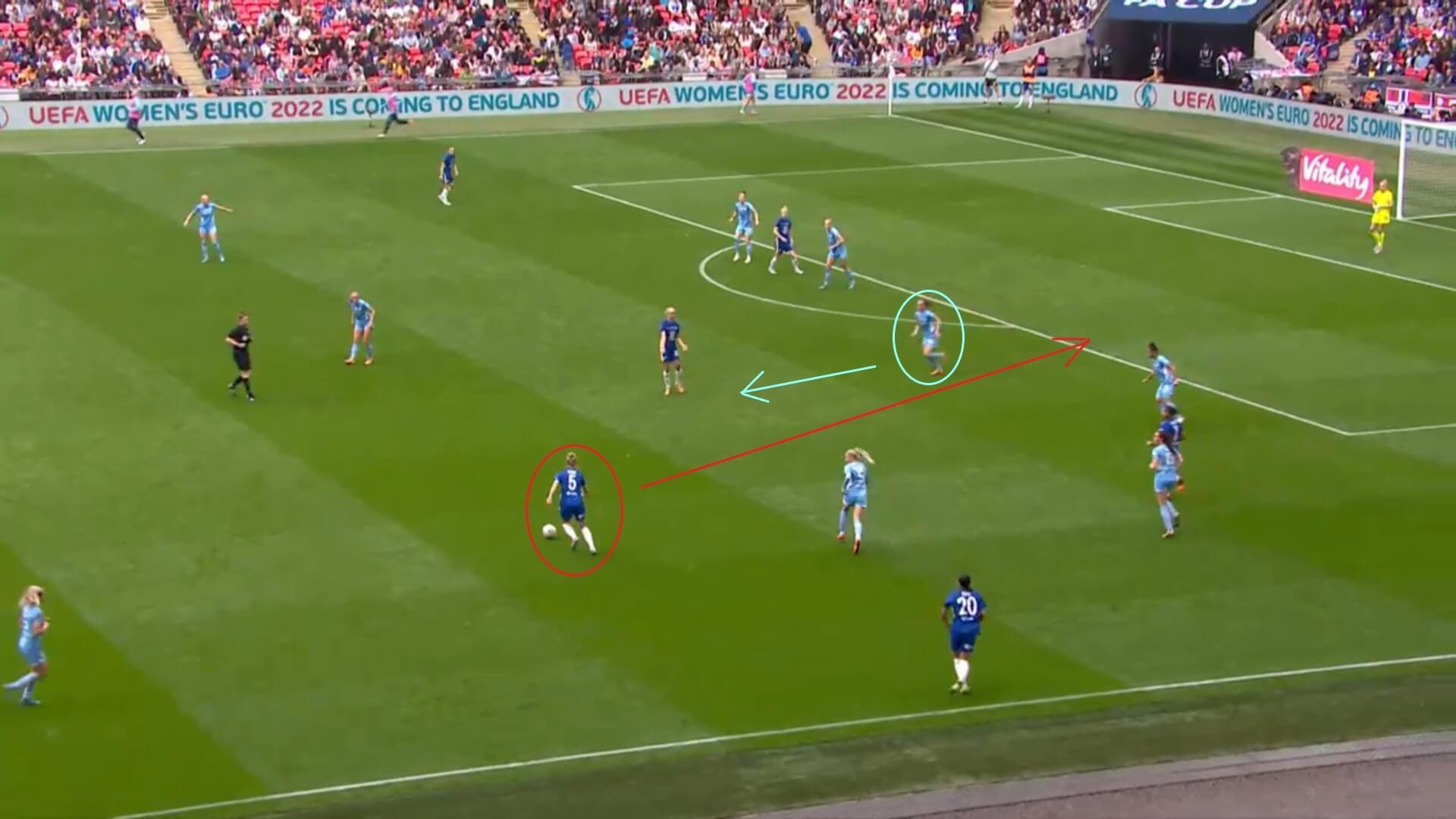
When going forwards, Chelsea turned their focus towards the second phase of each attacking move, with players required to make good support runs and offer passing options to the main attackers. Their method of attacking changed to long balls up the field which normally targeted Kerr, whilst other players then positioned themselves in areas where they could receive a back pass and then look for a gap ahead of them in which to pass or shoot through.
This situation demonstrates how this tactic worked, and the key thing to mention is that it brought the midfielders into play much more, therefore giving Chelsea more options to move the ball to. Here, Kerr has passed backwards to Wales midfielder Sophie Ingle, who is now in a good position to play the ball into a teammate and build an attack. Manchester City have seen Harder’s positioning and Walsh has come towards her, as shown by the blue arrow, but this leaves the gap open in their defensive line for Chelsea to play the ball through, which was the aim of this tactic.
For further proof of how this change helped Chelsea to retake control of proceedings, Erin Cuthbert’s second half goal came from England laying the ball back to her just as Kerr did for Ingle here, whilst Kerr’s second goal came from a long pass up the field that Manchester City defender Alanna Kennedy misjudged, so this tactic was a key reason for Chelsea going on to win the game.
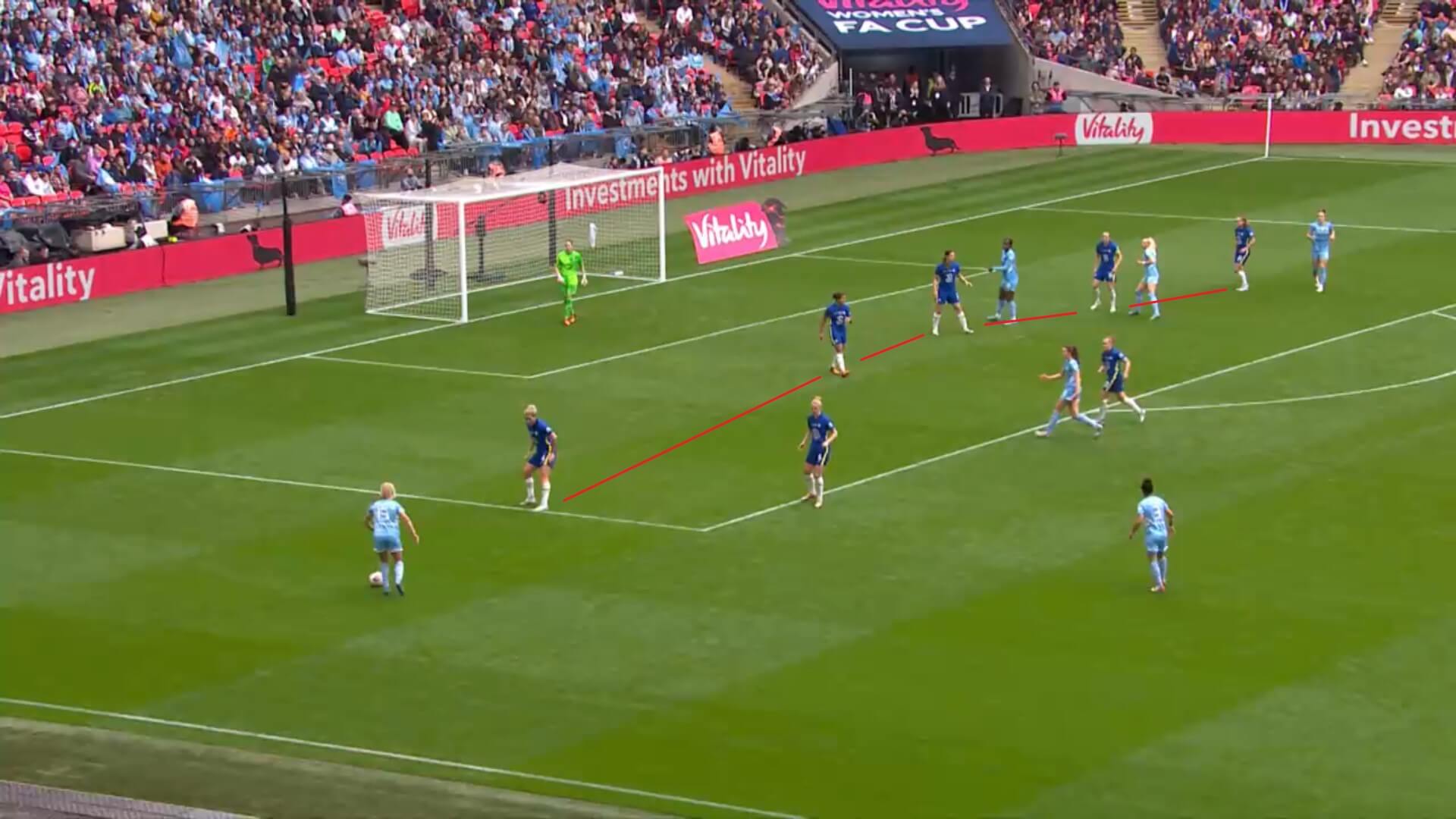
Chelsea’s defensive alterations meant that Manchester City couldn’t apply the same pressure as they had been beforehand, with the wing-backs getting back and Chelsea looking more organised as a result. Manchester City’s wide forwards didn’t have as much time on the wings as they had in the first half, meaning that the service into the middle and the ability of Hemp and Kelly to influence the game was more limited.
This was also helped by Millie Bright switching to right wing-back for part of the second half, whilst Jess Carter moved further inside, as this allowed the more physical Bright to get tighter to Hemp, as the biggest threat, whilst Carter has proven this season to be a good aerial defender and worked hard to clear anything that did come into the box. Therefore, again, we can see how Chelsea’s tactical changes helped them to win the game.
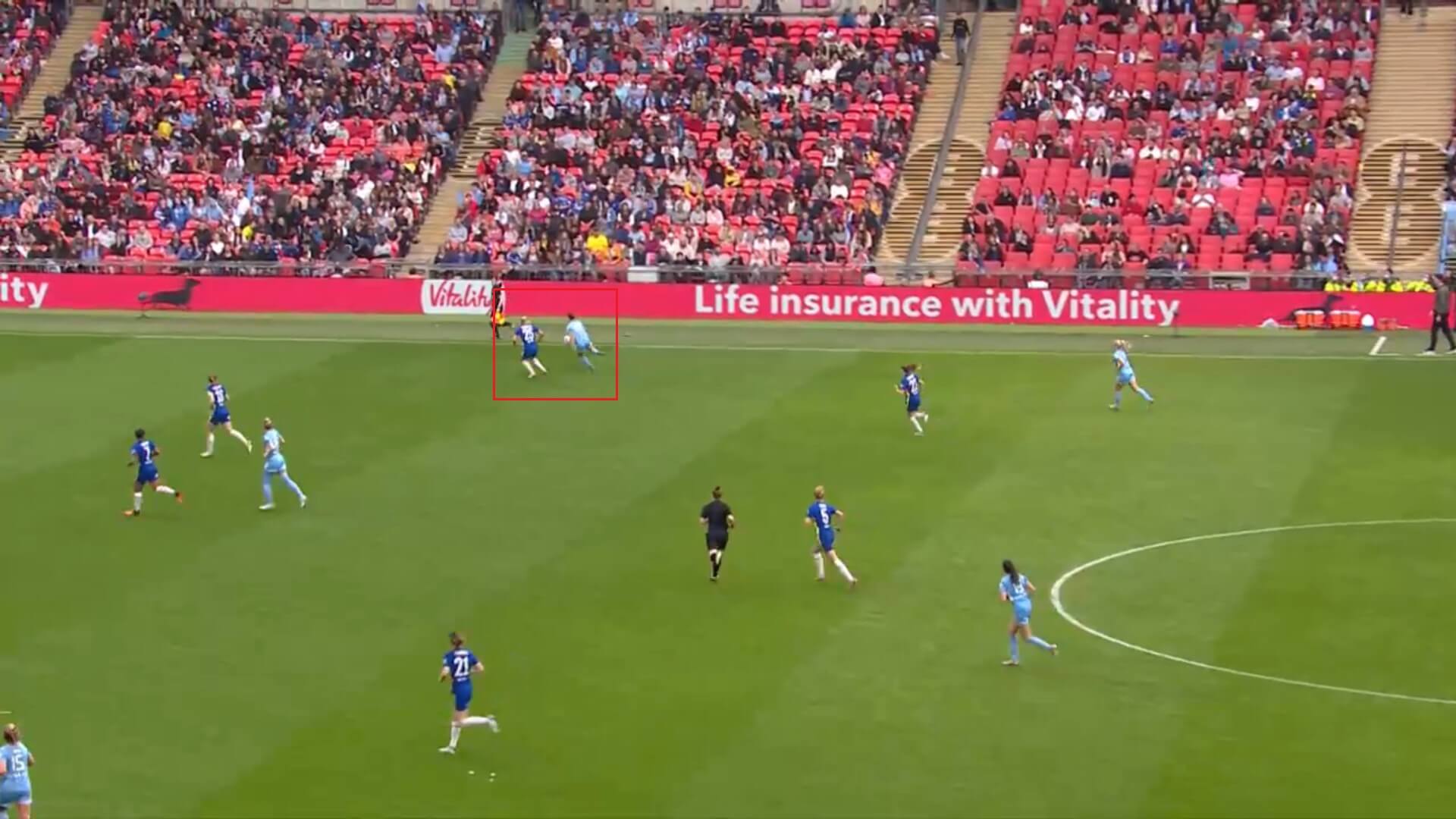
As mentioned, once Raso came on for Manchester City, Chelsea struggled to deal with her direct threat, and Reiten’s defensive shortcomings became more exposed. As a result, Jonna Andersson was introduced at the beginning of extra time and immediately solved the problem, with the Sweden international, who was playing her final game for Chelsea, a left-back by trade. Therefore, she naturally stayed further back and filled in the holes that Reiten had been leaving open, tracking Raso and limiting her influence on the game.
This was only a small change and perhaps an obvious one to make as Chelsea looked to limit what Manchester City could do in extra time, but it made a big difference and enabled them to see out the game once Kerr had scored her second.
Conclusion
In conclusion, this tactical analysis has looked at the 2022 FA Cup final, finding the reasons why Chelsea Women managed to get past a battling Manchester City Women in what turned out to be a thriller of a match. The analysis has looked at Manchester City’s attacking play, seeing how they had a setup from which they could build attacks and put early pressure on Chelsea, as well as how Emma Hayes’ side started slowly but grew into the game, with second-half tactical alterations helping to fix the issues that they had experienced before the break.
Hayes said in her post-match comments that her players have a determination not to lose, and this character is what ultimately got them over the line, gaining revenge for their Continental Cup final defeat by Gareth Taylor’s side back in March. Meanwhile, Manchester City will lament their lack of final third quality and individual defensive mistakes but can still be proud of a season in which they can also take positives and look to build on in 2022/2023.





Comments